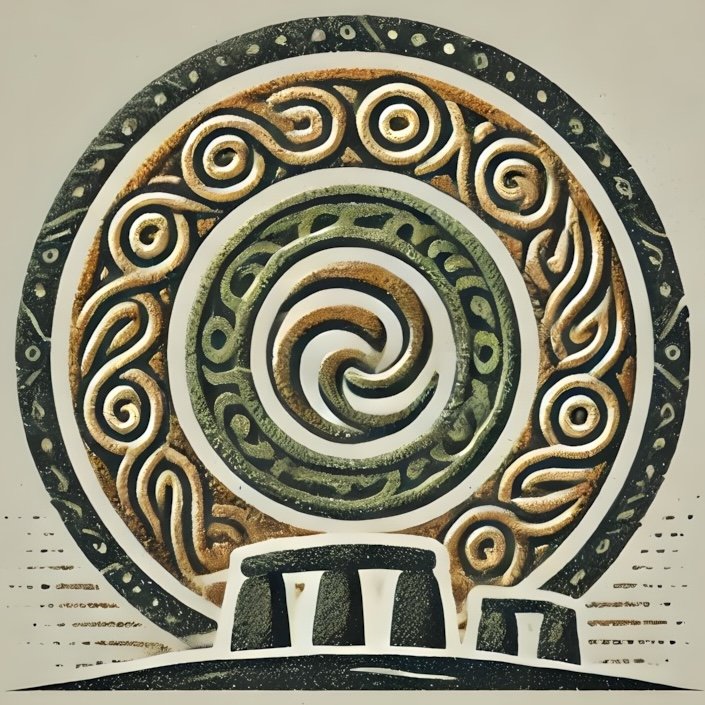Introduction to Mythological Context
Irish mythology is a rich tapestry woven from the threads of ancient stories, heroic deeds, and the interplay of gods and mortals. Central to this mythology are figures like the Dagda, a powerful god associated with fertility, strength, and magic. The Dagda is not just a deity of abundance; he is also a symbol of the connections between music, power, and the heroic cycles that define Irish lore. This pillar page explores the Dagda’s harp, its significance in the context of heroic cycles, and its broader implications for understanding Irish prehistory, particularly through the lens of hillforts and warfare.
The Dagda: An Overview
The Dagda, often referred to as the “Good God,” is one of the most important deities in the Tuatha Dé Danann, the mythical race of gods and heroes in Irish mythology. He embodies many qualities: he is a father figure, a warrior, and a master of the arts. The Dagda is typically depicted as a large, jovial man wielding a massive club that can kill and revive, symbolizing his control over life and death. His association with fertility and abundance is complemented by his magical cauldron, which never empties.
The Dagda’s character is multifaceted, representing both the nurturing aspects of nature and the fierce power of a warrior. His stories often intertwine with those of other legendary figures, showcasing the complex relationships and conflicts that define the heroic cycles of Irish mythology.
The Dagda’s Harp
Among the Dagda’s many possessions, his harp stands out as a powerful symbol of his divine authority and musical prowess. This enchanted instrument, known as the “Cláirseach,” is said to have the ability to control emotions and influence the hearts of listeners. When played, the harp could summon joy, sorrow, or even sleep, showcasing the profound connection between music and the human experience.
The harp is not merely an instrument; it represents the power of art and creativity in shaping reality. In a culture where oral tradition was paramount, the Dagda’s harp serves as a reminder of the importance of storytelling and music in preserving history and culture. The Dagda’s mastery over this instrument highlights the belief that music can be a tool of both peace and warfare, capable of swaying the hearts of warriors and kings alike.
Heroic Cycles in Irish Mythology
The heroic cycles of Irish mythology are narratives that chronicle the adventures and trials of legendary figures, often set against the backdrop of ancient landscapes and hillforts. These cycles include tales of the Ulster Cycle, the Fenian Cycle, and the Historical Cycle, each featuring a cast of heroes, warriors, and gods.
The Ulster Cycle, for instance, revolves around the hero Cú Chulainn and the kingdom of Ulster. It is characterized by themes of honor, bravery, and the tragic consequences of conflict. The Fenian Cycle, on the other hand, focuses on the exploits of Fionn mac Cumhaill and his band of warriors, the Fianna, emphasizing themes of loyalty and heroism in the face of adversity.
These cycles not only entertain but also serve as moral and ethical guides, reflecting the values and beliefs of ancient Irish society. They are deeply intertwined with the landscape, with many tales linked to specific locations, such as hillforts and ancient burial sites, which still resonate with visitors today.
Connections Between the Dagda’s Harp and the Heroic Cycles
The Dagda’s harp and the heroic cycles are interconnected in several ways. First and foremost, the harp symbolizes the power of storytelling, a crucial element in the transmission of heroic tales. Music and poetry were essential in preserving history and culture, allowing the deeds of heroes to be remembered and celebrated through generations.
Moreover, the emotional resonance of the Dagda’s harp parallels the emotional journeys of the heroes within these cycles. Just as the harp can evoke joy or sorrow, the stories of Cú Chulainn and Fionn mac Cumhaill explore the full spectrum of human experience, from triumph to tragedy. The ability of the harp to influence emotions mirrors the impact of these heroic tales on the audience, fostering a sense of shared identity and cultural continuity.
Additionally, the Dagda’s role as a warrior god aligns with the themes of conflict and power that permeate the heroic cycles. His mastery of music and magic positions him as a pivotal figure in the struggles between the Tuatha Dé Danann and their adversaries, illustrating how art and warfare are often intertwined in the pursuit of power.
Cultural Significance of Music in Warfare and Power
In ancient Irish society, music was not merely a form of entertainment; it held significant cultural and political weight. The ability to inspire warriors through song or to sway the hearts of kings was a powerful tool in both warfare and governance. The Dagda’s harp exemplifies this connection, as music was believed to possess the ability to alter the course of battles and influence the outcomes of conflicts.
Songs and stories served to bolster morale among warriors, instilling a sense of unity and purpose. They also functioned as a means of recording history, ensuring that the deeds of heroes and the lessons of warfare were passed down through generations. The cultural significance of music in this context cannot be overstated, as it shaped the very fabric of Irish identity and community.
Archaeological and Historical Evidence
The connections between the Dagda’s harp, heroic cycles, and the landscape of Ireland are bolstered by archaeological and historical evidence. Hillforts, such as those found at Emain Macha and Dun Aonghasa, serve as physical manifestations of the power struggles depicted in the heroic cycles. These sites were not only strategic military locations but also centers of cultural and social life, where music and storytelling would have played a vital role.
Artifacts such as musical instruments, weapons, and ceremonial objects provide insight into the importance of music and warfare in ancient Irish society. The discovery of harps and other instruments in burial sites suggests that music was integral to rituals and celebrations, reinforcing the idea that the Dagda’s harp was more than just a mythical object; it was a reflection of the cultural values of the time.
Contemporary Interpretations and Legacy
Today, the legacy of the Dagda’s harp and the heroic cycles continues to resonate in contemporary culture. Modern interpretations of these myths can be found in literature, music, and art, showcasing the enduring appeal of these ancient stories. Festivals celebrating Irish mythology often feature music and storytelling, drawing on the rich heritage of the past to inspire new generations.
Moreover, the connections between music, power, and identity remain relevant in contemporary discussions about cultural heritage and the role of art in society. The Dagda’s harp serves as a symbol of the power of creativity to shape our understanding of history and identity, reminding us of the importance of preserving and celebrating our cultural roots.
Mythological Links: The Dagda’s Harp and the Heroic Cycles
As visitors explore the landscapes of Ireland, they encounter not only the remnants of ancient civilizations but also the echoes of the stories that have shaped the nation. The Dagda’s harp, with its magical ability to influence emotions and connect people, stands as a testament to the enduring power of music and mythology in the human experience.

